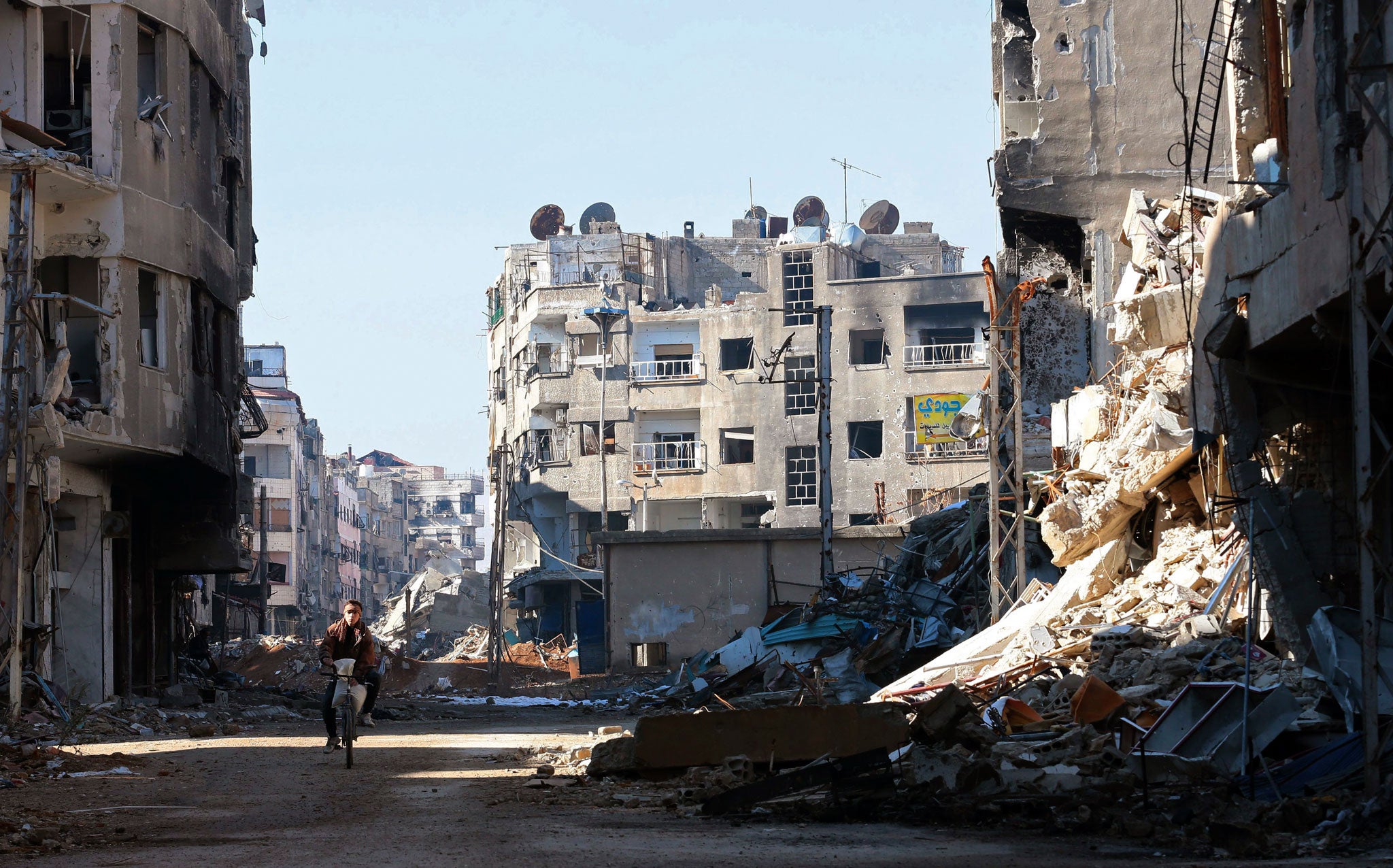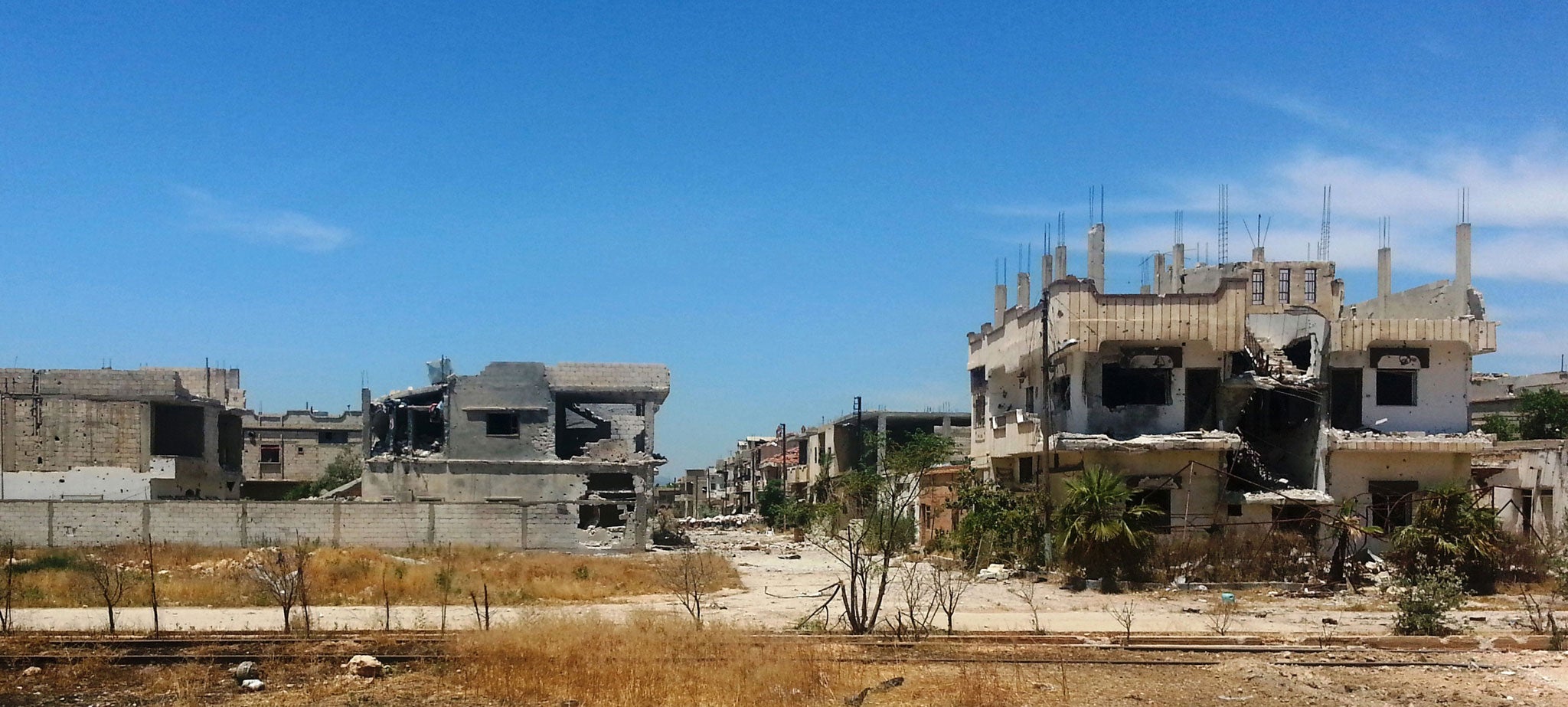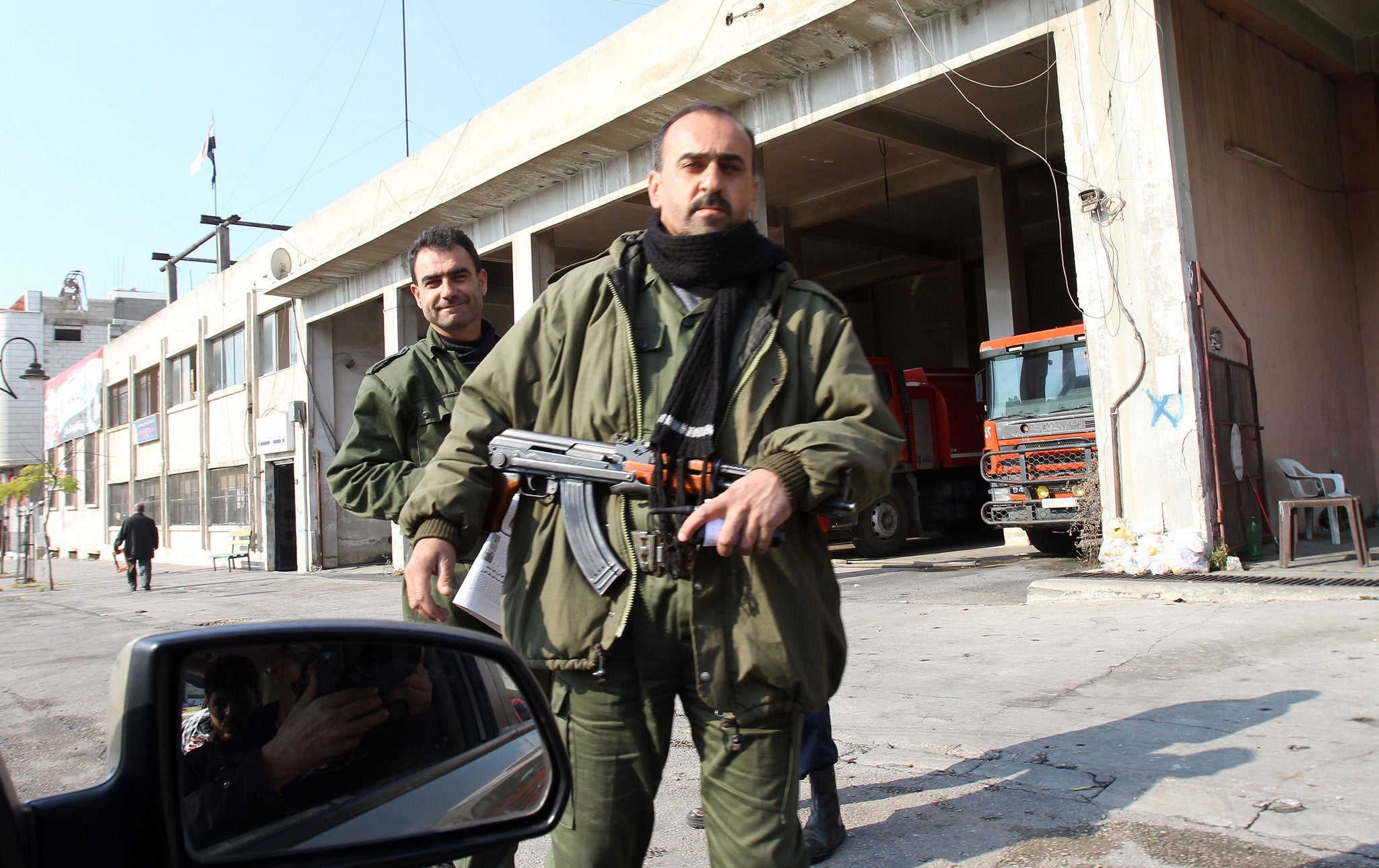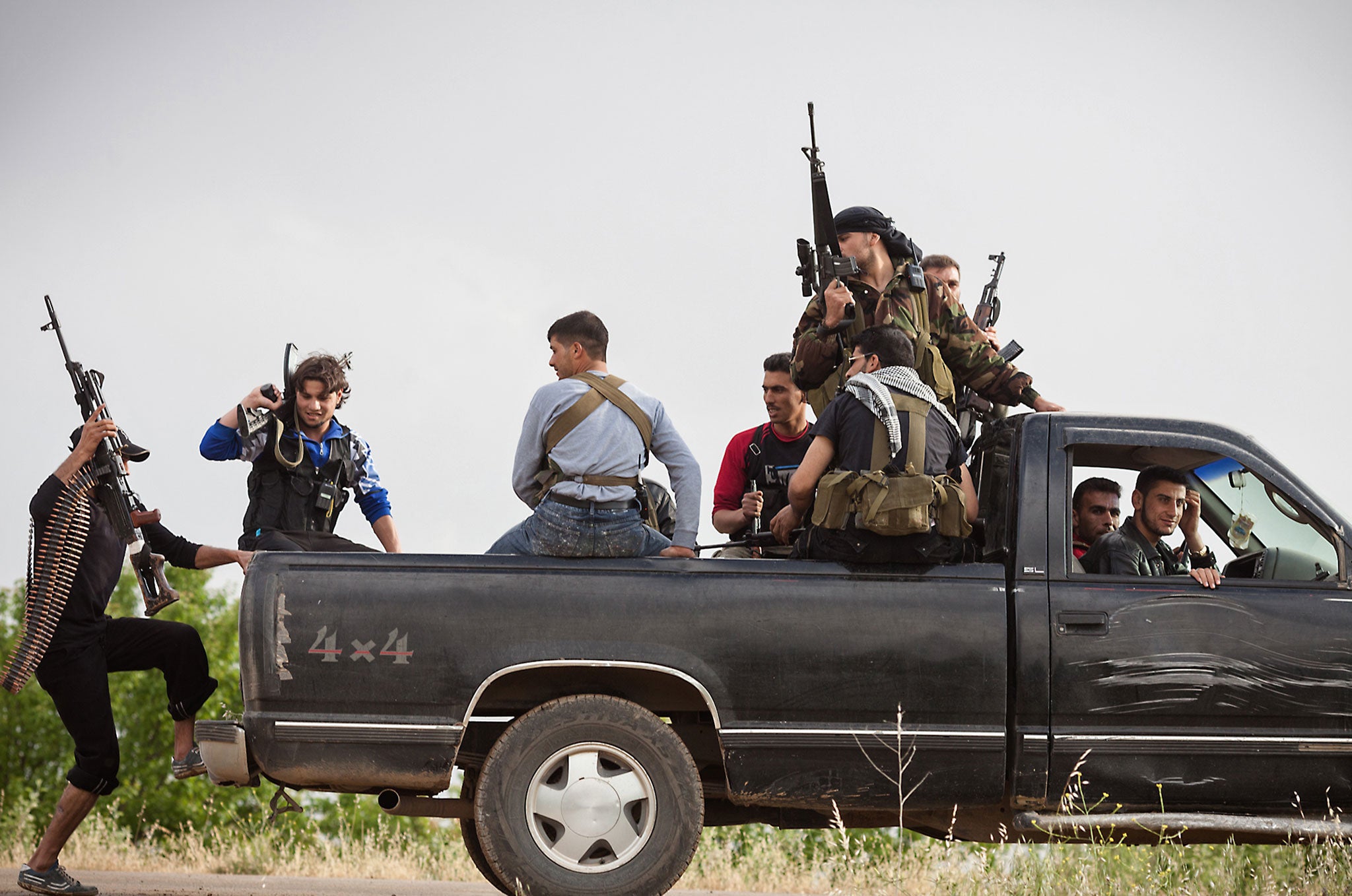Syria's road to hell: A hair-raising journey between Damascus and Tartous
The road between Damascus and Tartous is so fraught with danger that the mere thought of travelling down it makes Patrick Cockburn's stomach tighten. Here, he recounts his most recent journey

In every war there is a city, a town, a mountain, a river or a road that all sides see as crucial if they are going to win, or at least avoid defeat. In the Syrian civil war, it is the road linking Damascus to Homs, Syria's third city, 100 miles to the north, which then goes west for 64 miles until it reaches the port city of Tartous on the Mediterranean coast. The route is so important because it connects the parts of Syria held by the government. If it is ever cut off permanently, it will be a crippling blow to the rule of President Bashar al-Assad.
It is a road I have got to know far too well in the past two years. When I think about driving it, I feel a tightening of the muscles in my stomach. There is nothing suicidal about the journey, but the risk is always there, and even after I have discussed the dangers involved with my careful, highly-informed and courageous driver George, a Syrian Christian, I wonder if there is something nasty ahead we don't know about.
We watch for signs that will give us advanced warning of danger, such as a lack of traffic coming towards us on the other side of the road, which could mean vehicles are being stopped by some trouble we cannot yet see. A good flow of traffic probably means that all is well, particularly if there are a lot of buses, since Syrian bus drivers go everywhere and are skilled in assessing risks. Heavy vehicles loaded high with valuable goods are also excellent news, because the driver would not be risking his cargo if he thought it might be stolen or destroyed.
I was last on this road in early February and I knew it had been closed for 17 days a month earlier after rebels captured most of the town of An Nabk, halfway to Homs. But George's mother comes from Nabk and he assured me that government troops were firmly back in control and there was no need to worry. Not everybody was so positive: an experienced foreign journalist advised me to fly to Latakia on the coast in north-west Syria and then drive south to Homs. He said that if I was going to drive to Homs from Damascus, it was worth hiring a second car to drive behind my own to make sure I was not followed. He had got through all right, but the second car had been stolen by armed bandits on the way back to Damascus.
It is the first few miles of the main highway north which make me most nervous. They go past districts such as Qaboun, Harasta, Barzeh and Douma that were or are rebel strongholds, but have been ravaged by artillery fire or systematically bulldozed. Viewed from the car window, I see a landscape of ruins with broken walls and concrete floors sandwiched on top of each other. Most of the time there is nobody to be seen as we speed past mile after mile of ruins, but that does not mean that a sniper is not looking at us through the sights of his rifle. The car showrooms that used to line this road are now burnt out and abandoned. The Mercedes building was a focus for rebel resistance and has taken a terrible battering.

We drive very fast and only stop once at a government checkpoint under a bridge. These are regular troops in uniform and not the National Defence Force (NDF) militia, because the area is still a potential battleground. As in most places in Syria – and this reminds me of Lebanon during the civil war 30 years ago – there is an intricate jigsaw puzzle of zones held by forces loyal to the government and zones controlled by rebels. Even this oversimplifies the situation on the ground, because in places like Barzeh there is a negotiated ceasefire, with rebel Free Syrian Army (FSA) fighters and government soldiers jointly manning checkpoints, while inside Barzeh armed FSA men are still in charge.
The military geography of Syria often follows its sectarian geography. We drive past tall buildings which are undamaged where most of the inhabitants are Alawites, the Shia sect to which President Assad and much of Syria's ruling elite belongs. As we exit the northern outskirts of Damascus, George looks more relaxed and says encouragingly, "That is 80 per cent of the dangerous parts of this journey over". Somehow, I don't feel comforted. A little to my surprise, he is not too worried about the proximity of Ma'loula, a Christian village built in a spectacular ravine in the mountains just off the road to the west that we had visited last summer. These days, all the Christians have fled and it is partly in the hands of Jabhat al-Nusra, the Syrian affiliate of al-Qa'ida, which has gunmen in buildings and caves overlooking the town. I thought it would not take much for these jihadis to push down from the mountain and block the road.
A strange aspect of the war in this part of Syria is how close the combatants are to each other. In a few cases there are negotiated ceasefires, but others seem to be local truces (or a live-and-let-live understanding between the adversaries) that are always fragile and vulnerable to somebody breaking it. This is particularly true of the part of the road which George and I were about to drive down, because clearly visible on a hill off to the left is the town of Yabroud, which is held by Jabhat al-Nusra, but mysteriously still has a large population of Christians who have not fled.
Some deal is evidently in operation, but nobody quite knows what it is. The deal does not apply to strangers, and somebody had fired a shot at us 18 months earlier in just this area, and the bullet had whistled by uncomfortably close to our car. The Syrian Army had been bombarding Yabroud, but this did not necessarily mean it would launch a ground assault. The government is short of combat troops and uses them sparingly, usually to keep open roads vital to itself, or to block routes important to the rebels' supply network.
I had heard a lot in Damascus about the army's coming offensive against Yabroud, but had decided that I would believe it when I saw it. On the other hand, the brief capture of Nabk, a few miles beyond Yabroud, by the opposition in December, might have made the government decide that it was time to secure this important piece of the road, possibly in a combined attack with the Lebanese paramilitary Hezbollah movement, whose forces were just across the border in Lebanon.

Nabk was firmly back in government hands at the time we were there, and the authorities had arranged a victory celebration in the undamaged centre of the town. We turned off the main road to have a look. I am not a great fan of this type of demonstration, with school children playing the main part, because local people are under the gun and do not have any alternative but to take part.
The rally did show, however, that the government was pretty confident that it was in control. I also learnt an interesting fact, which was that the NDF militiamen policing the demonstration had previously been members of the rebel FSA until a couple of months earlier. They had simply switched sides, though nobody knew on what terms.
Unfortunately, nobody should imagine that these deals mitigate the violence of the war anywhere in Syria. In Nabk, there were mutual accusations of atrocities, and just north of the town, at Dayr Atiyah, there was a hospital on a hill where the rebels were said to have killed the doctors. I learnt later that they had also broken into a folk museum and stolen ancient firearms and tried to make them battle-worthy again. Buildings close to the main road were pock-marked with bullet holes and some had been hit by shells, but the damage was not as bad as in Damascus.
Two other points need to be made about this journey. Every six or seven miles, there was a government checkpoint which George and I were likely to get through because we had the right papers and authorisations, but our swift passage was not a complete certainty and a single suspicious soldier might delay us for hours. Secondly, on this road, all the while we were just to the east of the Qalamoun mountain range, which marks the border with Lebanon. It is traditionally a smuggling region and, until last year, nothing much had changed other than the fact that these days, it was men, weapons and ammunition which were being transported. Then in June, the government had won one of its few decisive ground battles of the war, thanks to Hezbollah, whose fighters had stormed al-Qusayr, a rebel-held town on the plain through which the rebels had reinforced and re-supplied their fighters in Homs. I had been in Qusayr just after it had fallen to Hezbollah and it was badly hit, though not wholly destroyed.
I spent the night in Homs and then turned west, taking the road to Tartous, a city where there are many Alawites and which is firmly on the government's side. After success at Qusayr, the government is tightening its grip here.

As we leave Homs, on our right is a big area of tall modern buildings called al-Wa'ar, whose 400,000 inhabitants are Sunni and where Sunnis from the rest of Homs have taken refuge. Wa'ar is blockaded and it is difficult to get in or out, though it is not quite so tightly besieged as the Old City of Homs, which has been at the centre of international attention. Jacoub El Hillo, the head of the UN humanitarian effort, told me later: "I wish that people would understand that there are other sieges in Syria aside from the Old City of Homs."
This is an important strategic area. Homs oil refinery is just to the south of the road and had been hit by mortar fire, though not badly damaged. Later in the day, I saw a Syrian Army tank manoeuvre on the road before firing a shell into Wa'ar. A little further west, the road passes through the Homs Gap, with low mountains on either side of the highway, making this a much-fought-over route down the centuries.
Control of the Homs Gap is why the Knights Hospitallers spent so much money in the 13th century building the Krak des Chevaliers, the greatest Crusader castle in the world, with its massive towers and huge concentric masonry walls. I was trying to pick out the fortress on its distant hill when its white stones were suddenly illuminated by a shaft of sunlight – like a castle in a Renaissance painting. I was sorry I could not get closer, but it is held by rebels based in two Sunni villages, al-Zahra and al-Hosn, at its base. The villages have been blockaded for months, but what makes Zahra important are the oil and gas pipes, as well as the electricity lines that go through it – the rebels had been blowing them up.

I visited a hospital in Talkalakh, a town just off the road and close to the Lebanese border, where I hoped to find soldiers wounded in a government attack on Zahra. The doctors denied any wounded were there, but I met a civilian called Ahmad Mohammed, who said he had been shot in the hand and thigh while milking a cow. The old man who was with him had been killed. He appeared to come from an Alawite village and I wondered if he had been shot for sectarian reasons. This part of Syria is very much like Lebanon, with villages with different sectarian allegiances – Sunni, Christian, Alawite – turning into armed camps. A little further west and we were in Tartous, a fine, peaceful city and a government stronghold, but with one wall in the centre covered with pictures of some 2,000 of its young men who have been killed serving in the Syrian Army.
My journey showed that in this part of Syria, the government is expanding its control and the rebels are under pressure. But the expansion is slow and the army is overstretched. The road was more secure than it had been six months earlier, but it was still vulnerable to a sudden attack.
It also reminded me that Syria is more than ever a patchwork of different circumstances, depending on the military situation and which sects predominate. Much of what I had heard in Beirut and Damascus about what was happening turned out to be mistaken, and media reporting has been full of certainties that melted away in the face of reality. In Syria, more than most places, only eyewitness information is worth much and even then it swiftly becomes outdated. That being so, sometime in the course of the year, I am likely to find myself back on the risky but always interesting road from Damascus to Tartous.
Join our commenting forum
Join thought-provoking conversations, follow other Independent readers and see their replies
0Comments